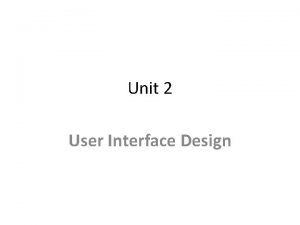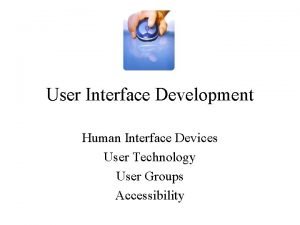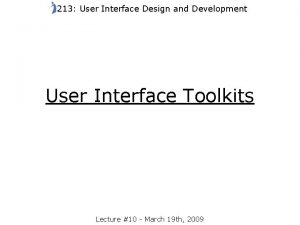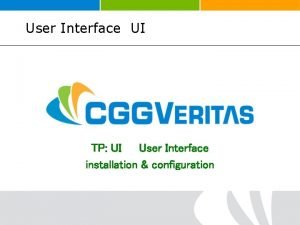User Interface Development Target or Specific User Groups












- Slides: 12

User Interface Development Target or Specific User Groups

User Groups Specific Groups include: • Children • Adults • Senior Citizens • People with disabilities (including partially sighted, blind, motor problems) • Other groups with specific requirements

Children suffer poor usability system design as much as adults. Problems with children’s attitude to the internet: • Lack of patience • Don’t like slow downloads • Fancy wording causes confusion (young children can’t read • Unclear navigation causes confusion • Don’t filter information • Don’t discriminate between adverts and content

Children Kids like: • • Interactive movies Animation Sounds/Noises Games • • Colourful designs Familiarity between interfaces Content with rooms maps 3 D visuals Funny content Children are willing to “minesweep” to find interactive elements. More willing to understand clear systems.

Children Remember that within each user group there are many sub-groupings: • • Younger children under 3 Between 3 years and 5 years 5 - 10 years 10 + years Be aware of the range of your target audience. Examples of children’s web sites: BBC Webland

Adults are a broad user band, probably the largest, from teenagers through to older adults. The interests are therefore varied and harder to group. Problems with adults attitude to the web are: • Impatience in download time • Less requirement for animation for the sake of it (this is probably not always true with the younger adult) • Flash intros cause annoyance • Unwanted sound is a distraction • No control of interface causes anxiety and distress • Unclear navigation cause frustration

Adults like: • Relevant content • Clear content information • Animation (where required) • Well designed and clear interfaces • Full control over the interface and elements • Appropriate colour schemes • Games (where relevant) • Navigation and page consistency Sites for adults include: BBC Taylor Guitars John Lewis

Senior citizens are the largest growth group using the internet. Areas of interest include: • Research • News • Investment tracking • General research • Researching medical conditions

Senior citizens How do we solve these issues? • • Increased functionality Clear navigation systems Clear lettering and use of fonts Clear contrast in colours used in type layout Most used facility on the internet is email. Due to reduced mobility online shopping is becoming more popular.

Disabled Users Legislation went through in 2004, stating that public spaces must be made usable for disabled users. This includes web sites. This way of increasing the availability of internet information is referred to as accessibility. More information on this subject is found at Jakob Neilsen’s web site.

Disabled Users Various elements must be considered when designing a web site for disabled users. Things to consider: • Alt Tags on images - placed within html to provide screen reading availability • Clear and obvious navigation • Colours that do not cause reading problems (red and green are problematic) • Resizable text, do not make text too small and fixed in size • CSS - style sheets are becoming the way to build web sites • Interface accessibility, how easy is it to move around screen • Interface that fits into small screen resolution (it used to be 640 x 480, now with larger screens becoming more available 800 x 600 is fine.

Disabled Users This user group is so varied that visual impairment is probably the largest area to consider as a designer due to the visual content of the web. Other disabilities will relate to hardware issues. Some machines have in-built options to change the display, alter colour and contrast, provide screen reading and magnification abilities. More recent evidence has shown that offering text alternative sites excludes the disabled viewer rather than include them. Flash sites are not accessible at the moment but this may change in time. Depending on the user group Flash is not recommended for disabled users.
 Primary target market and secondary target market
Primary target market and secondary target market How are ethnic groups and religious groups related
How are ethnic groups and religious groups related What is interface in java
What is interface in java Office interface vs industrial interface
Office interface vs industrial interface Industrial interfaces
Industrial interfaces An interface
An interface Psychographic groups media
Psychographic groups media Weight formula with density
Weight formula with density Specific gravity pharmacy
Specific gravity pharmacy Qad user groups
Qad user groups Qad midwest user group
Qad midwest user group Raintree user groups
Raintree user groups Yahoo user interface
Yahoo user interface























